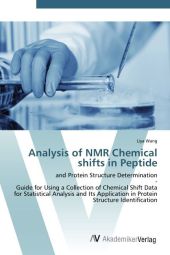 Neuerscheinungen 2012Stand: 2020-01-07 |
Schnellsuche
ISBN/Stichwort/Autor
|
Herderstraße 10
10625 Berlin
Tel.: 030 315 714 16
Fax 030 315 714 14
info@buchspektrum.de |

Liya Wang
Analysis of NMR Chemical shifts in Peptide
and Protein Structure Determination - Guide for Using a Collection of Chemical Shift Data for Statistical Analysis and Its Application in Protein Structure Identification
Aufl. 2012. 236 S.
Verlag/Jahr: AV AKADEMIKERVERLAG 2012
ISBN: 3-639-43385-8 (3639433858) / 3-8364-5773-3 (3836457733)
Neue ISBN: 978-3-639-43385-2 (9783639433852) / 978-3-8364-5773-6 (9783836457736)
Preis und Lieferzeit: Bitte klicken
Revision with unchanged content. Chemical shifts provide detailed information about non-covalent structure, solvent interactions, ionization constants, ring orientations, hydrogen bond interactions, and other phenomena. Since different chemical shift data sets are not necessarily comparable without corrections or adjustments, the applicability of statistical analysis of NMR chemical shifts to biomolecules has so far been limited. We use the term "congruent" to describe data sets that can be directly used for statistical analysis after proper adjustments. Congruence problems in chemical shift analysis can occur at three different levels. (1) At the protein level, when using collections of chemical shifts of proteins reported by different groups. (2) At the residue level, when using collections of chemical shifts of different residues, here random coil chemical shifts must be subtracted. (3) At the refined residue level, when using collections of chemical shifts of same residues, neighboring residue effects on the chemical shifts need to be taken into account. In this book, these correction or adjustment problems are addressed based on the newly proposed robust statistical models.
received the B.S. degree in applied chemistry and computer sciences from USTC, Hefei, China in 1998 and 1999, the M.S. degree in biomedical engineering and computer sciences from UW-Madison in 2003 and 2005, and the Ph.D. degree in biophysics from UW-Madison in 2006. His research interests include data analysis, and machine intelligence.


